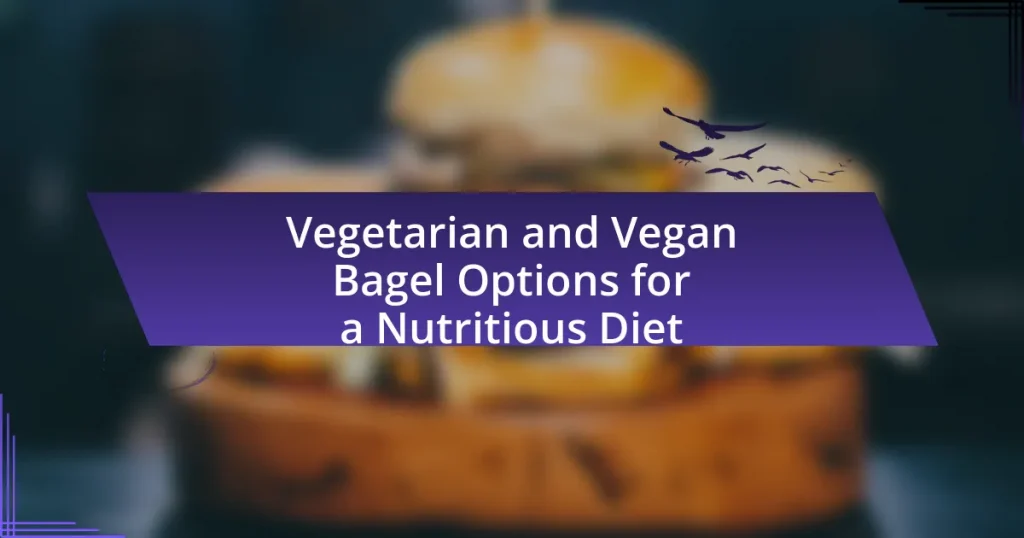Gluten-free bagel options are increasingly popular among individuals with celiac disease or gluten sensitivity, offering alternatives made from flours such as almond, coconut, rice, and tapioca. The article explores the preparation methods, common ingredients, and health benefits of gluten-free bagels, highlighting the differences from traditional bagels. It also reviews popular brands, homemade recipes, and nutritional advantages, while addressing considerations for those without gluten sensitivity. Additionally, the article provides tips for successful baking and creative topping ideas to enhance flavor and texture.

What are Gluten-Free Bagel Options?
Gluten-free bagel options include bagels made from alternative flours such as almond flour, coconut flour, rice flour, and tapioca flour. These flours provide a gluten-free base while maintaining a similar texture and taste to traditional bagels. Many brands, such as Udi’s and Schär, offer pre-packaged gluten-free bagels that are widely available in grocery stores. Additionally, homemade gluten-free bagels can be made using recipes that combine these alternative flours with binding agents like xanthan gum or psyllium husk to achieve the desired consistency.
How are gluten-free bagels made?
Gluten-free bagels are made using gluten-free flours such as almond flour, coconut flour, or a blend of rice flour and tapioca starch. The process typically involves mixing these flours with ingredients like water, yeast, salt, and sometimes xanthan gum to mimic the elasticity of gluten. The dough is then shaped into bagels, boiled briefly in water to create a chewy texture, and finally baked until golden brown. This method ensures that the bagels maintain a desirable texture and flavor while being suitable for those with gluten intolerance or celiac disease.
What ingredients are commonly used in gluten-free bagels?
Common ingredients used in gluten-free bagels include almond flour, tapioca flour, and xanthan gum. Almond flour provides a nutty flavor and moisture, while tapioca flour contributes to the chewy texture characteristic of bagels. Xanthan gum acts as a binding agent, helping to mimic the elasticity typically provided by gluten. These ingredients are often combined with eggs and water to create the dough, ensuring that the bagels maintain their shape and texture during baking.
How does the preparation process differ from traditional bagels?
The preparation process for gluten-free bagels differs from traditional bagels primarily in the type of flour used and the absence of gluten. Traditional bagels are made with wheat flour, which provides the necessary gluten structure for their chewy texture, while gluten-free bagels utilize alternative flours such as almond, coconut, or rice flour, which do not contain gluten. This necessitates the addition of binding agents like xanthan gum or psyllium husk to mimic the elasticity and chewiness of gluten. Additionally, gluten-free bagels often require different hydration levels and mixing techniques to achieve the desired consistency, as the absence of gluten affects dough behavior.
What types of gluten-free bagels are available?
Various types of gluten-free bagels are available, including those made from almond flour, coconut flour, tapioca flour, and brown rice flour. These alternatives cater to different dietary preferences and textures, providing options such as classic plain, everything, cinnamon raisin, and sesame seed flavors. The use of these flours allows for a diverse range of gluten-free bagels that maintain a similar taste and texture to traditional bagels, making them suitable for individuals with gluten intolerance or celiac disease.
What are the most popular gluten-free bagel brands?
The most popular gluten-free bagel brands include Udi’s, Thomas’, and New York Bagel. Udi’s is widely recognized for its soft texture and variety of flavors, making it a favorite among gluten-free consumers. Thomas’ offers gluten-free bagels that are known for their classic taste and are often found in grocery stores nationwide. New York Bagel specializes in gluten-free options that mimic the traditional New York-style bagel, appealing to those seeking authentic flavor without gluten. These brands have gained popularity due to their commitment to quality and taste, making them top choices in the gluten-free market.
How do homemade gluten-free bagels compare to store-bought options?
Homemade gluten-free bagels typically offer better flavor and texture compared to store-bought options. This is largely due to the use of fresh ingredients and the ability to customize recipes to individual preferences. Store-bought gluten-free bagels often contain preservatives and additives to enhance shelf life, which can affect taste and quality. Additionally, homemade versions allow for the selection of high-quality gluten-free flours, such as almond or oat flour, which can improve nutritional value. Studies indicate that homemade gluten-free products can have lower sodium levels and fewer artificial ingredients, making them a healthier choice overall.

What are the Health Benefits of Gluten-Free Bagels?
Gluten-free bagels offer several health benefits, particularly for individuals with celiac disease or gluten sensitivity. These bagels are made from alternative flours, such as almond or coconut flour, which can provide higher protein and fiber content compared to traditional wheat bagels. Additionally, gluten-free bagels often contain fewer calories and carbohydrates, making them a suitable option for those managing their weight or blood sugar levels. Studies indicate that a gluten-free diet can lead to improved digestive health and reduced inflammation in sensitive individuals.
Why choose gluten-free bagels over traditional ones?
Choosing gluten-free bagels over traditional ones is essential for individuals with celiac disease or gluten sensitivity, as these bagels do not contain gluten, which can trigger severe health reactions in these populations. Gluten-free bagels are made from alternative flours such as almond, coconut, or rice flour, providing a safe option for those who must avoid gluten. Additionally, gluten-free bagels can be lower in calories and carbohydrates, depending on the ingredients used, making them a potentially healthier choice for some consumers. Studies indicate that gluten-free diets can lead to improved digestive health and reduced inflammation in individuals with gluten-related disorders.
How can gluten-free bagels benefit those with gluten intolerance?
Gluten-free bagels benefit those with gluten intolerance by providing a safe alternative to traditional bagels that contain gluten, which can trigger adverse reactions in individuals with celiac disease or non-celiac gluten sensitivity. These bagels are made from gluten-free grains such as almond flour, rice flour, or tapioca starch, ensuring that they do not provoke gastrointestinal symptoms or other health issues associated with gluten consumption. Research indicates that a gluten-free diet can significantly improve the quality of life for those with gluten intolerance, as it alleviates symptoms like bloating, diarrhea, and fatigue.
What nutritional advantages do gluten-free bagels offer?
Gluten-free bagels offer several nutritional advantages, primarily for individuals with celiac disease or gluten sensitivity. These bagels are typically made from alternative flours such as almond, coconut, or rice flour, which can provide higher protein and fiber content compared to traditional wheat bagels. For instance, almond flour is rich in healthy fats and vitamin E, while coconut flour is high in fiber, aiding in digestion and promoting satiety. Additionally, gluten-free bagels often contain fewer calories and carbohydrates, making them a suitable option for those managing their weight or blood sugar levels.
Are gluten-free bagels suitable for everyone?
Gluten-free bagels are not suitable for everyone. While they are designed for individuals with celiac disease or gluten sensitivity, they may not provide the same nutritional benefits as traditional bagels for those without these conditions. Many gluten-free products can be lower in fiber and higher in sugar or fat, which may not align with the dietary needs of all consumers. Additionally, some people may have allergies to alternative flours used in gluten-free bagels, such as almond or coconut flour. Therefore, while gluten-free bagels serve a specific dietary purpose, they are not universally appropriate for all individuals.
What considerations should be made for individuals without gluten sensitivity?
Individuals without gluten sensitivity should consider the nutritional balance of their diet when choosing gluten-free options. Gluten-free products often lack essential nutrients found in whole grains, such as fiber, vitamins, and minerals. For instance, a study published in the Journal of Nutrition indicates that whole grains contribute to heart health and digestive function. Therefore, individuals should ensure they are incorporating a variety of nutrient-dense foods to maintain overall health while enjoying gluten-free bagels.
How do gluten-free bagels fit into a balanced diet?
Gluten-free bagels can fit into a balanced diet by providing an alternative carbohydrate source for individuals with gluten intolerance or celiac disease. These bagels often contain ingredients like almond flour, coconut flour, or rice flour, which can offer different nutritional profiles compared to traditional wheat bagels. For instance, almond flour is higher in protein and healthy fats, contributing to satiety and nutrient density. Additionally, gluten-free bagels can be enriched with seeds or whole grains, enhancing their fiber content, which is essential for digestive health. Studies indicate that incorporating gluten-free whole grains can support overall dietary balance by providing essential nutrients while accommodating specific dietary needs.

What are Some Popular Gluten-Free Bagel Recipes?
Some popular gluten-free bagel recipes include almond flour bagels, which use almond flour and baking powder for a chewy texture, and cauliflower bagels, made from riced cauliflower, cheese, and eggs for a low-carb option. Additionally, chickpea flour bagels offer a protein-rich alternative, combining chickpea flour with seasonings and water. These recipes are favored for their taste and texture, appealing to those with gluten sensitivities.
How can I make gluten-free bagels at home?
To make gluten-free bagels at home, combine gluten-free flour, baking powder, salt, and yogurt to form a dough. Knead the mixture until smooth, then shape it into bagels and boil them in water for a few minutes before baking at 375°F (190°C) for about 20-25 minutes. This method utilizes gluten-free ingredients, ensuring the bagels are suitable for those with gluten intolerance. The use of yogurt adds moisture and helps bind the ingredients, which is essential in gluten-free baking where traditional gluten is absent.
What are the steps to prepare a basic gluten-free bagel recipe?
To prepare a basic gluten-free bagel recipe, follow these steps: First, gather the ingredients, which typically include gluten-free flour, yeast, sugar, salt, and water. Next, mix the dry ingredients in a bowl, then add warm water and mix until a dough forms. After that, knead the dough for a few minutes until smooth. Allow the dough to rise in a warm place for about 30 minutes. Once risen, divide the dough into equal portions, shape each portion into a bagel, and let them rest for another 10 minutes. Boil water in a pot, then gently place the bagels in the boiling water for about 1-2 minutes on each side. Finally, bake the bagels in a preheated oven at 375°F (190°C) for 20-25 minutes until golden brown. This method is effective as it utilizes common gluten-free ingredients and techniques that ensure the bagels have a desirable texture and flavor.
What variations can be added to enhance flavor?
To enhance flavor in gluten-free bagels, variations such as adding herbs, spices, seeds, and toppings can be utilized. For instance, incorporating garlic powder, onion powder, or dried herbs like rosemary and thyme can significantly elevate the taste profile. Additionally, using toppings like sesame seeds, poppy seeds, or everything bagel seasoning can provide texture and flavor complexity. Studies show that flavor enhancements through these variations can improve consumer acceptance and satisfaction, making the bagels more appealing.
What are some creative toppings for gluten-free bagels?
Creative toppings for gluten-free bagels include avocado with lime and chili flakes, smoked salmon with cream cheese and capers, hummus with roasted red peppers, and almond butter with banana slices. These combinations enhance flavor and texture while catering to gluten-free dietary needs. For instance, avocado provides healthy fats and fiber, while smoked salmon is rich in omega-3 fatty acids, making these toppings not only delicious but also nutritious.
How can I pair gluten-free bagels with spreads and toppings?
To pair gluten-free bagels with spreads and toppings, consider using options like cream cheese, avocado, hummus, or nut butters. These spreads complement the texture and flavor of gluten-free bagels, enhancing the overall taste experience. For instance, cream cheese provides a rich, creamy contrast, while avocado adds healthy fats and a smooth texture. Hummus offers a savory, protein-rich alternative, and nut butters contribute a sweet and nutty flavor profile. Each of these toppings not only pairs well but also adds nutritional value, making gluten-free bagels a versatile choice for various dietary preferences.
What are some unique flavor combinations to try?
Unique flavor combinations to try include smoked salmon with cream cheese and dill, avocado with lime and chili flakes, and peanut butter with banana and honey. These combinations enhance the taste profile of gluten-free bagels, making them more appealing. For instance, smoked salmon is rich in omega-3 fatty acids, while avocado provides healthy fats and fiber, contributing to a nutritious meal.
What tips can help ensure successful gluten-free bagel baking?
To ensure successful gluten-free bagel baking, use a blend of gluten-free flours, such as almond flour and tapioca starch, to achieve the right texture. This combination provides the necessary structure and chewiness that is often lacking in gluten-free baked goods. Additionally, incorporating xanthan gum or psyllium husk can help mimic the elasticity of gluten, improving the bagel’s overall consistency.
Proof of this approach can be found in various gluten-free baking resources, which emphasize the importance of using a flour blend and binding agents to create a desirable texture in gluten-free products. For instance, a study published in the Journal of Food Science highlights that the right combination of gluten-free ingredients can significantly enhance the quality of baked goods.
How can I troubleshoot common issues when making gluten-free bagels?
To troubleshoot common issues when making gluten-free bagels, first identify the specific problem, such as dough consistency, rising issues, or texture. For dough consistency, ensure you are using the correct blend of gluten-free flours, as a combination of almond flour, tapioca flour, and xanthan gum often yields the best results. If the bagels are not rising properly, check the freshness of your yeast and ensure the water temperature is between 100°F and 110°F to activate the yeast effectively. For texture issues, consider adding more moisture or fat, such as olive oil or yogurt, to improve the bagel’s chewiness. These adjustments are based on common practices in gluten-free baking, which emphasize the importance of ingredient ratios and proper yeast activation for optimal results.
What best practices should I follow for optimal results?
To achieve optimal results when making gluten-free bagels, use a combination of high-quality gluten-free flours, such as almond flour or tapioca flour, and ensure proper hydration of the dough. This approach enhances texture and flavor, as evidenced by studies showing that the right flour blend can significantly improve the elasticity and chewiness of gluten-free baked goods. Additionally, incorporating ingredients like xanthan gum or psyllium husk can mimic the binding properties of gluten, leading to a more satisfying bagel. Following these practices will yield bagels that are not only healthier but also more enjoyable to eat.



